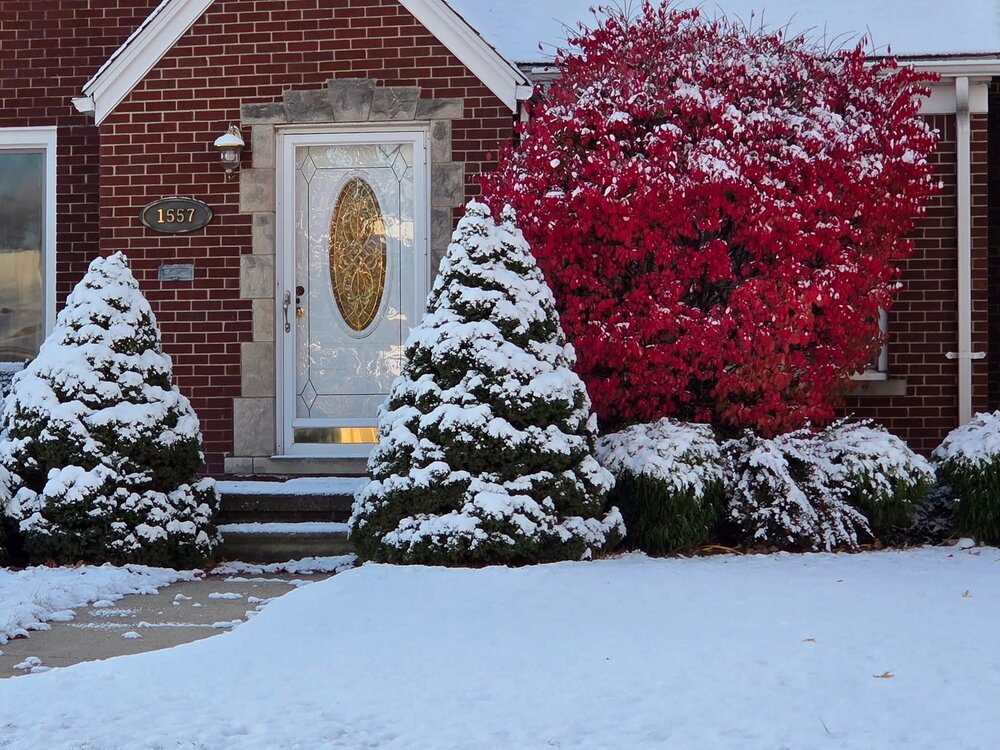-
Posts
17,760 -
Joined
-
Last visited
Content Type
Profiles
Blogs
Forums
American Weather
Media Demo
Store
Gallery
Everything posted by michsnowfreak
-
Funny thing is 2016-17 had a very good December. It was the rest of the winter that was mild.
-

2025-2026 ENSO
michsnowfreak replied to 40/70 Benchmark's topic in Weather Forecasting and Discussion
In Michigan we get more winter than the east coast and we get it noticeably earlier. I would never be worried about a winter if I wasn't seeing lots of snow on models by the start of December. If anyone SERIOUSLY (and not trolling) is jumping off a ledge on the east coast in mid November...Just wow. Especially when so many have pointed out many good signs. -
I know what youre saying. But honestly December looking pretty good. Haven't said that in years.
-

11/8-11/10 First Snow and Lake Effect Event
michsnowfreak replied to Geoboy645's topic in Lakes/Ohio Valley
What was the approximate snowfall totals downtown/on the lakeshore? I know it had to be more than ORD. -
December is looking good. The cold did not go poof, it just delayed a bit. As for the cutter going poof. I have a outdoor event Friday so im happy, I did not want rain. But I hope it's not a sign of things to come for winter.
-

Fall 2025 Medium/Long Range Discussion
michsnowfreak replied to Chicago Storm's topic in Lakes/Ohio Valley
It was surprisingly good for so far out, although the snow band in southern MI needed to be more south/east and into NW OH. -

2025-2026 ENSO
michsnowfreak replied to 40/70 Benchmark's topic in Weather Forecasting and Discussion
Ive been suspecting that for months for here in the Great Lakes, and im getting more confident now that we have hit mid November. -

11/8-11/10 First Snow and Lake Effect Event
michsnowfreak replied to Geoboy645's topic in Lakes/Ohio Valley
Do you have a link for these maps? -

2025-2026 ENSO
michsnowfreak replied to 40/70 Benchmark's topic in Weather Forecasting and Discussion
It was not record breaking here, however the 2.2" snowfall on November 9th was much earlier than avg (avg first measurable snow is Nov 17th and avg first 1"+ snowfall is Nov 30th) and the high temp of 31F on November 10th missed the record low max by 3F. Right around this time in 2019, record early heavy snow AND cold were occurring here. -

2025-2026 ENSO
michsnowfreak replied to 40/70 Benchmark's topic in Weather Forecasting and Discussion
2010-11 here: Nov: T, Dec: 9.2", Jan: 18.0", Feb: 31.8", Mar- 9.1", Apr- 1.3", total 69.4". A very solid wall to wall winter here. -

2025-2026 ENSO
michsnowfreak replied to 40/70 Benchmark's topic in Weather Forecasting and Discussion
Although it doesnt directly apply to the Great Lakes, I read your outlook and you did a fantastic job. You explained/laid out everything re: your thoughts on winter 2025-26. -

2025-2026 ENSO
michsnowfreak replied to 40/70 Benchmark's topic in Weather Forecasting and Discussion
I agree to a point. Some of the recent years with unusually wintry novembers followed by unusually tame Decembers was weird. To happen once, no biggie. But it happened multiple times. But then, sometimes you get slammed in January and February and forget about how December was meh. Especially since December is busy with Christmas activities and January and February are boring. All that said, I'm really hoping for a great December then when January starts we will worry about that. One month at a time. -

2025-2026 ENSO
michsnowfreak replied to 40/70 Benchmark's topic in Weather Forecasting and Discussion
The absolute lack of any warm signal in December from the Euro Weeklies day after day, especially in an era when longrange models often climo-correct themselves/lean warm, is a great sign. Im surprisingly in agreement with snowman in that it is textbook La Nina. Ive said it many times, historically December is a great winter month in a La Nina in the Great Lakes, and last December was on the mild side and very underwhelming, despite my having high hopes initially. Then again, Feb was cold, constant deep winter, another unusual month that didnt follow the La Nina textbook. Ill roll the dice and gamble on a cold, snowy December and worry about February when it gets here lol. -

2025-2026 ENSO
michsnowfreak replied to 40/70 Benchmark's topic in Weather Forecasting and Discussion
Thanks! Yes, thats a burning bush. Its not my house, i just thought it looked cool lol. While the Fall colors are past peak, there are a few hanging on and they created beautiful and unusual scenes this morning. We had 2.5" total, but the first half was very heavy, wet 4-1 ratio snow in the morning, some afternoon melting while still snowing, then more fluffy snow in the evening. The excitement of the first snow never gets old. -

2025-2026 ENSO
michsnowfreak replied to 40/70 Benchmark's topic in Weather Forecasting and Discussion
Snowed all day here in SE MI yesterday and throughout the Great Lakes. Mid 20s with wind chills in the teens this morning and a winter wonderland. Snow is falling in KY and TN today and record cold is plunging into the south with freeze warnings over the entire southeast and into Florida. It's not going to last, and the east will miss the brunt, but to already see type a large cold snap like this before mid November can't be a bad sign. -

11/8-11/10 First Snow and Lake Effect Event
michsnowfreak replied to Geoboy645's topic in Lakes/Ohio Valley
Neat event. Looks like the jackpot areas saw 10-12". Over here, our 1.2" of heavy wet snow yesterday half melted then we got another 1.3" from the Lake Huron band in the evening. It was gorgeous this morning as the last gasps of autumn mixed with the early touch of winter, temps in the mid 20s with wind chills mid teens. Snow totals were 2.5" my backyard, 2.2" DTW. Some areas in the thumb/Port Huron saw 4-6". Totals varied widely throughout SE MI, with some spots getting as little as 0.5" to as much as 6". Detroit-south saw the most snow in the morning (1-3") and then the eastern suburbs saw the most in the evening (1-6").- 213 replies
-
- 13
-

-

2025-2026 ENSO
michsnowfreak replied to 40/70 Benchmark's topic in Weather Forecasting and Discussion
It has begun. The first snow today. Absolutely beautiful and it NEVER gets old. Just over an inch, wouldve been more without the early November ground temps and 32-33 air temps. But the first snow always tells me...its show time! I notice the weeklies got their colder look back as well. -

11/8-11/10 First Snow and Lake Effect Event
michsnowfreak replied to Geoboy645's topic in Lakes/Ohio Valley
It was absolutely gorgeous this morning. Had it been a few degrees colder or few weeks later in the season, it would have been 2-3". Instead we got 1.1" here with 1.2" at DTW. I belive Ann Arbor got 1.5-2" and 2-2.5" near the ohio border. The magic of the first snow....only 5 months til the last snow lol!- 213 replies
-
- 10
-

-
Early November. Brisk air and gray skies.
-

2025-2026 ENSO
michsnowfreak replied to 40/70 Benchmark's topic in Weather Forecasting and Discussion
Todays weeklies are colder than yesterday starting December 1st. They oscillate often. But so far no warm signal at all in December. -

2025-2026 ENSO
michsnowfreak replied to 40/70 Benchmark's topic in Weather Forecasting and Discussion
I would expect nothing less from NMME. if i recall, it was even warmer last winter, and we know how that worked out. -

2025-2026 ENSO
michsnowfreak replied to 40/70 Benchmark's topic in Weather Forecasting and Discussion
They jump a lot. And you now have access https://charts.ecmwf.int/products/extended-anomaly-2t?base_time=202511070000&projection=opencharts_north_america&valid_time=202511170000 https://charts.ecmwf.int/?facets={"Product type"%3A[]%2C"Parameters"%3A[]%2C"Type"%3A[]%2C"Range"%3A["Extended (42 days)"%2C"Sub-seasonal"]} -
Regardless of what snow happens Sunday morning. The meso features on models after that look interesting too
-

2025-2026 ENSO
michsnowfreak replied to 40/70 Benchmark's topic in Weather Forecasting and Discussion
Hey we all want snow in our backyard, so not selfish at all. Very excited for our first snow here Sunday. -
Congrats on the job! And yes, come up and visit!





